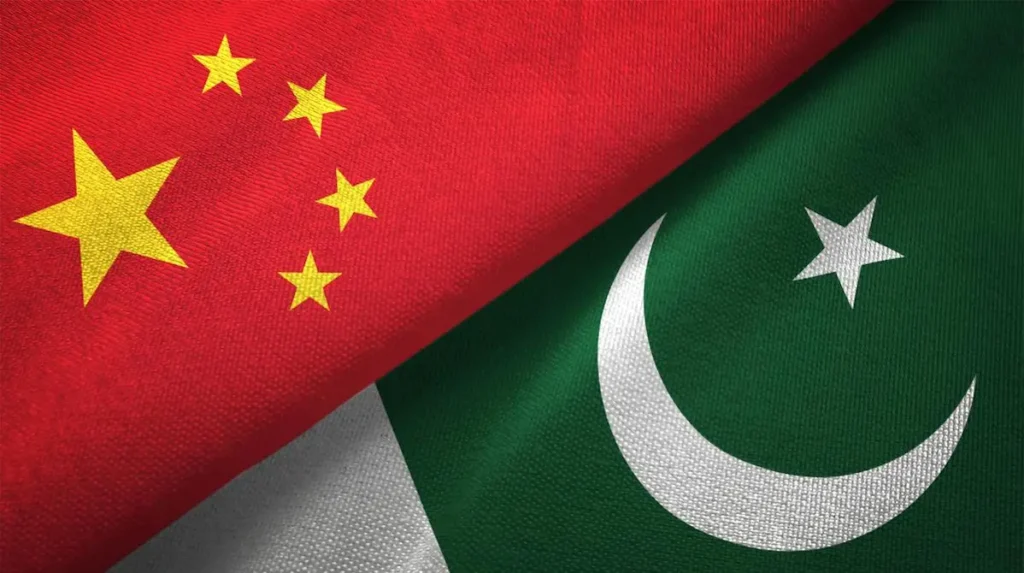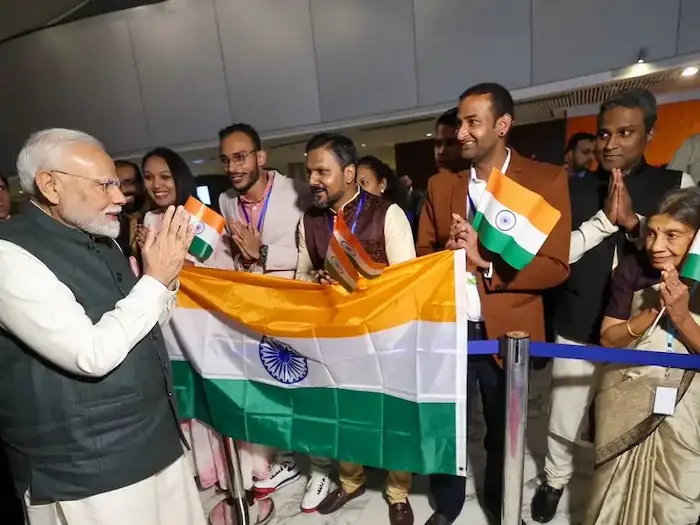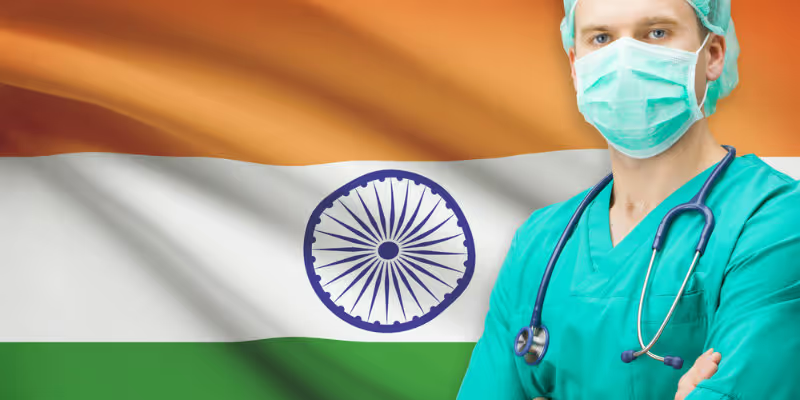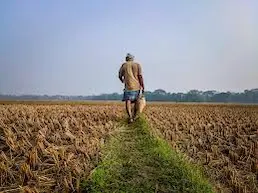1. The New Battle Challenge of China-Pakistan Collusion – International Relations

Why in News?
Operation Sindoor (May 7–10) revealed a significant evolution in the China-Pakistan relationship—from a strategic partnership to active military and operational collaboration. This development was officially acknowledged by Lt. Gen. Rahul R. Singh, Deputy Chief of Army Staff.
Key Highlights:
1. From Passive to Active Strategic Collusion
- Earlier, China’s role was limited to diplomatic or rhetorical support to Pakistan.
- Now, China is directly engaged in battlefield operations, offering tactical support and real-time ISR (Intelligence, Surveillance, Reconnaissance).
2. Digital and Psychological Warfare
- Chinese state media and online influencers actively participated in propaganda warfare, projecting India as the aggressor.
- This media narrative management aims to delegitimize India’s military actions globally.
3. New Strategic Normal
- The Indo-Pak-China triangle is no longer hypothetical—collusion is operational.
- India’s strategic response must now factor in the possibility of coordinated dual-front aggression.
4. China’s Arms Diplomacy
- China used this conflict to demonstrate the efficacy of its military platforms, boosting its global arms exports and deepening Pakistan’s reliance on Chinese systems.
5. Two Live Borders
- India faces simultaneous threats:
- Western border: Ongoing tensions with Pakistan.
- Northern border: Persistent standoff with China in Ladakh and Arunachal.
- This demands a two-front preparedness strategy with high resource allocation and intelligence coordination.
Implications for India:
- Reassess military doctrines, procurement priorities, and strategic partnerships.
- Strengthen cyber and information warfare capabilities.
- Enhance tri-service integration and readiness across both fronts.
- Deepen cooperation with like-minded countries through platforms like QUAD and IBSA.
Exam Connect – Possible Questions
Prelims
- Operation Sindoor, recently in the news, is associated with:
A. Anti-Naxal operations
B. Indo-China border standoff
C. China-Pakistan military collusion
D. Naval exercise in the Indian Ocean
Answer: C. China-Pakistan military collusion - The acronym ISR stands for:
A. Integrated Security Reconnaissance
B. International Surveillance Regulation
C. Intelligence, Surveillance, and Reconnaissance
D. Indian Strategic Readiness
Answer: C. Intelligence, Surveillance, and Reconnaissance
Mains
- “The China-Pakistan collusion has entered a new phase of battlefield cooperation.” In light of this, critically examine the strategic challenges India faces in maintaining regional stability. (200 words)
- Discuss the implications of simultaneous threats on India’s northern and western fronts. What steps can be taken to enhance India’s strategic preparedness?
- How is digital and psychological warfare shaping the nature of modern conflicts? Evaluate India’s readiness in this domain.
2. India’s Five-Nation Tour: Strengthening Ties with the Global South – International Relations

Why in News?
Prime Minister Narendra Modi’s diplomatic visit to Ghana, Trinidad and Tobago, Argentina, Brazil, and Namibia marks a significant strategic outreach to the Global South. The tour reflects India’s intent to reshape global diplomacy by building inclusive and equitable partnerships with developing nations.
Key Highlights of the Visit:
1. India-Ghana Comprehensive Partnership
- Diplomatic ties elevated to Comprehensive Partnership.
- Aim: Make Ghana a vaccine manufacturing hub for West Africa.
- MoU on pharmaceutical cooperation to improve access to generic medicines.
2. Critical Minerals and Energy with Argentina
- Collaboration on critical minerals (essential for EVs, electronics, defense).
- Exploration of shale gas and oil reserves, boosting India’s energy security.
3. Outreach to Caribbean and African Nations
- Engagement with Trinidad and Tobago and Namibia demonstrates India’s commitment to south-south cooperation and historical solidarity.
Broader Strategic
Renewed Global South Focus
- India is advocating for a multipolar world by empowering Global South countries.
- Striving to make international institutions (like UNSC, IMF) more representative and just.
Shared Historical Ties
- Common experience of colonialism and post-colonial development challenges.
- Continued legacy of Non-Aligned Movement (NAM) and cooperation through IBSA and BRICS.
India-Led Global Initiatives
- Vaccine Maitri: Sent COVID-19 vaccines to over 70 countries.
- International Solar Alliance (ISA): Promotes solar energy in developing countries.
- Digital Public Goods: India shares platforms like Aadhaar and UPI, helping nations build digital governance frameworks.
Role of the Indian Diaspora
- Strong presence in countries like Trinidad and Tobago enhances soft power.
- Diaspora acts as a bridge in diplomatic, cultural, and economic relations, particularly in shaping policies in countries like the U.S., Canada, and the Caribbean.
Implications for India:
- Positions India as a trusted leader in the Global South.
- Opens new avenues for resource access, energy security, and economic growth.
- Reinforces India’s soft power diplomacy via culture, technology, and health diplomacy.
- Helps counterbalance Chinese influence in Africa and Latin America.
Exam Connect – Possible Questions
Prelims
- Which of the following countries was NOT part of Prime Minister Narendra Modi’s recent five-nation tour?
A. Brazil
B. Argentina
C. Kenya
D. Ghana
Answer: C. Kenya - The ‘Vaccine Maitri’ initiative is associated with:
A. India’s clean energy export mission
B. Distribution of digital infrastructure to developing nations
C.Supply of COVID-19 vaccines by India to other countries
D. India’s climate diplomacy through BRICS
Answer: C. Supply of COVID-19 vaccines by India to other countries - The International Solar Alliance was co-launched by India with which country?
A. Germany
B. Brazil
C. France
D. South Africa
Answer: C. France
Mains
- “India’s engagement with the Global South is a strategic and moral imperative.” Discuss how India is leveraging this relationship to shape a more equitable world order. (200 words)
- Examine the role of India’s soft power—such as the diaspora, pharmaceuticals, and digital infrastructure—in advancing its foreign policy objectives in the Global South.
- Analyze the importance of critical minerals and energy cooperation in India’s foreign relations with Latin American countries like Argentina and Brazil.
3. Transforming Indian Healthcare: Achievements and Milestones (2014–2025) – Governance

Why in News?
India’s healthcare system has witnessed substantial transformation between 2014 and 2025, marked by policy reforms, technological interventions, and increased public health investment. These changes align with both national priorities under Ayushman Bharat, National Health Mission (NHM), and international commitments under UN SDG-3 (Good Health and Well-being).
Key Pillars of Healthcare Transformation:
1. Healthcare in 2014 – Starting Challenges
- Shortage of Primary Health Centres (PHCs) and diagnostics.
- Inadequate healthcare workforce and poor rural outreach.
- High Out-of-Pocket Expenditure (OOPE).
- Poor service quality and lack of universal access.
2. Policy Shift – Illness to Wellness
- Health reforms reoriented towards preventive and promotive care.
- National Health Mission (NHM) became the core of systemic health improvements.
3. Primary Healthcare Strengthening
- Over 1.77 lakh Ayushman Arogya Mandirs (Health and Wellness Centres) established for comprehensive care.
4. Digital and Remote Healthcare Access
- eSanjeevani: Provided over 14 crore teleconsultations.
- Tele-MANAS: Focused on mental health support.
5. Maternal and Child Health
- Maternal Mortality Ratio (MMR) and Infant Mortality Rate (IMR) showed a significant decline.
- Strengthened institutional deliveries and nutrition services.
6. Combating Non-Communicable Diseases (NCDs)
- Large-scale screenings for diabetes, hypertension, breast and cervical cancer.
- Health awareness and early intervention prioritized.
7. Universal Immunization and Disease Elimination
- Mission Indradhanush vaccinated millions of children and pregnant women.
- Successes in polio eradication and near-elimination of malaria in several districts.
8. Healthcare Financing and Affordability
- Public health expenditure rose from 1.13% to 1.84% of GDP.
- OOPE reduced from 62.6% to 39.4%.
- PM National Dialysis Programme and Ayushman Bharat – PM-JAY provided financial risk protection.
9. Human Resource Development and Infrastructure
- PM Ayushman Bharat Health Infrastructure Mission (PM-ABHIM) enhanced public health labs, critical care hospitals.
- 5.23 lakh additional health workers recruited, including Community Health Officers.
Strategic Impact:
- Progress toward Universal Health Coverage (UHC).
- Supports India’s goals under SDG-3.
- Builds resilience in the public health system, especially post-COVID-19.
- Strengthens rural health access, bridging the urban-rural divide.
Exam Connect – Possible Questions
Prelims
- Which of the following digital initiatives provides remote mental health consultations in India?
A. eSanjeevani
B. Aarogya Setu
C. Tele-MANAS
D. UHI
Answer: C. Tele-MANAS - Mission Indradhanush is primarily associated with:
A. Cancer screening
B. Mental health awareness
C. Universal immunization
D. Health infrastructure funding
Answer: C. Universal immunization - What is the current public health expenditure of India as a percentage of GDP (2025 figure)?
A. 1.13%
B. 1.84%
C. 2.5%
D. 3.0%
Answer: B. 1.84% - Out-of-Pocket Expenditure (OOPE) in India reduced from 62.6% in 2014 to:
A. 45.1%
B. 49.5%
C. 39.4%
D. 35.2%
Answer: C. 39.4%
Mains
- “India’s healthcare system has transitioned from an illness-based model to a wellness-focused approach.” Discuss the key policy reforms and achievements between 2014 and 2025 that contributed to this shift. (200 words)
- Evaluate the role of digital health technologies in improving healthcare access and quality in India. Cite examples such as eSanjeevani and Tele-MANAS.
- How has the Ayushman Bharat initiative helped India move toward Universal Health Coverage (UHC)? Highlight its impact on affordability and accessibility.
4. India Ranks 4th Most Equal Society: World Bank Spring 2025 Brief – Economy
Why in News?
India has been ranked as the 4th most equal country in the world in terms of income distribution according to the World Bank’s Spring 2025 Poverty and Equity Brief. This reflects a remarkable achievement in poverty alleviation and equitable economic growth.
Key Findings and Indicators:
1. Gini Index – Income Equality
- India’s Gini Score: 25.5 (2022–23)
- Interpretation: A lower score indicates more equal income distribution. India’s score is among the lowest globally, signifying strong equity.
2. Poverty Reduction Milestones
- 171 million people moved out of extreme poverty between 2011 and 2023.
- Poverty Headcount Ratio (2022–23):
- 2.3% of the population lives below $2.15/day (extreme poverty line).
- 5.3% lives below $3/day.
3. Shared Prosperity Premium
- This measures whether the bottom 40% of the population is growing faster than the national average.
- India showed a positive premium, indicating inclusive growth post-pandemic.
4. Global Standing
- India outperforms all G7 and G20 countries in income equality.
- Highlights India as a model for equitable growth among developing nations.
About the World Bank’s Poverty and Equity Brief:
- Published biannually, using household survey data and national statistics.
- Covers poverty trends, inequality metrics, and shared prosperity.
- Useful for cross-country comparisons and policy planning.
Implications for India:
Domestic:
- Validation of welfare and redistributive policies (e.g., DBT, rural employment schemes, food security programs).
- Reinforces the focus on inclusive development and targeting the bottom 40%.
Global:
- Enhances India’s image as a successful case study for inclusive growth in the Global South.
- Opens space for leadership in international development dialogues, particularly with low- and middle-income countries.
Exam Connect – Possible Questions
Prelims
- What does a Gini coefficient of 0 represent?
A. Absolute poverty
B. Moderate inequality
C. Perfect income equality
D. Perfect income inequality
Answer: C. Perfect income equality - According to the World Bank’s Spring 2025 Brief, how many people in India moved out of extreme poverty between 2011 and 2023?
A. 98 million
B. 110 million
C. 171 million
D. 220 million
Answer: C. 171 million - Shared Prosperity Premium is an indicator that measures:
A. The difference in GDP growth between two fiscal years
B. Whether the bottom 40% of the population experiences faster income growth than the national average
C. The subsidy provided on essential goods
D. The extent of wealth tax collected from the top 1%
Answer: B. Whether the bottom 40% of the population experiences faster income growth than the national average
Mains
- “India’s low Gini score and poverty reduction success mark a shift toward a more equitable economy.” Discuss the policies and structural factors that have contributed to this outcome. (200 words)
- Examine the relevance of income equality in promoting sustainable and inclusive economic development. How does India’s experience compare with that of developed economies?
- What is the significance of the Shared Prosperity Premium in evaluating growth? Analyze its utility in framing future welfare policies in India.
5. India Opposes Amendments to Plant Treaty Over Sovereignty Concerns – International Relations

Why in News?
India has strongly objected to proposed amendments to the International Treaty on Plant Genetic Resources for Food and Agriculture (ITPGRFA). The government and major farmers’ groups argue that the amendments could undermine seed sovereignty and dilute farmers’ rights.
About the International Plant Treaty (ITPGRFA):
- Established in 2001 under the Food and Agriculture Organization (FAO).
- Aims to:
- Conserve plant genetic resources.
- Promote sustainable agricultural practices.
- Ensure fair and equitable benefit-sharing, particularly in R&D and international collaborations.
Key Concerns Raised by India:
1. Expansion of the Multilateral System (MLS)
- Proposed amendment: Include all Plant Genetic Resources for Food and Agriculture (PGRFA).
- India’s position: Access should remain limited to a specific list of crops, as originally agreed, mainly those critical to food security.
2. Sovereignty at Risk
- The new proposal could:
- Subject India’s entire seed diversity to global access rules.
- Restrict customized national policies on seed usage and conservation.
- Allow foreign entities to access India’s germplasm without adequate benefit-sharing.
3. Threat to Farmers’ Rights
- India’s Seed Sovereignty Movement is rooted in farmers’ rights to save, use, exchange, and sell seeds.
- Standardized Material Transfer Agreements (MTAs) may infringe upon customary seed practices.
Institutional and Federal Responses:
ICAR (Indian Council of Agricultural Research)
- Assured that national interests will be safeguarded in negotiations.
- Dr. Sunil Archak, Principal Scientist, is leading India’s delegation.
States’ Involvement
- Kerala raised constitutional concerns:
- Agriculture is a State subject (Schedule VII, List II).
- Criticized the lack of consultation with State Governments and Biodiversity Boards.
Broader Implications for India:
- Could weaken local seed innovation and conservation initiatives.
- Threatens biological and cultural diversity of Indian agriculture.
- Risks creating dependence on foreign entities for seeds and planting material.
- Undermines federal autonomy in agriculture and biodiversity governance.
Exam Connect – Possible Questions
Prelims
- The International Treaty on Plant Genetic Resources for Food and Agriculture (ITPGRFA) was established under which organization?
A. WTO
B. UNEP
C. FAO
D. UNDP
Answer: C. FAO - Which of the following best describes the Multilateral System (MLS) under the Plant Treaty?
A. Trade arrangement for food grains
B. Global climate monitoring system
C. System for exchanging plant genetic materials
D. Universal food pricing mechanism
Answer: C. System for exchanging plant genetic materials - Under which list of the Indian Constitution is Agriculture placed?
A. Union List
B. State List
C. Concurrent List
D. Residual Powers
Answer: B. State List
Mains
- “The proposed expansion of the Plant Treaty’s Multilateral System threatens India’s seed sovereignty.” Critically examine the implications of this proposal for Indian agriculture. (200 words)
- Discuss the challenges India faces in balancing international treaty obligations with the protection of farmers’ traditional rights and national interests.
- Analyze the role of federalism in shaping agricultural and biodiversity policies in India. How can better coordination between the Centre and States improve outcomes?
6. The ‘Khelo Bharat Niti 2025’ as a Beacon for Indian Football – Governance

Why in News?
India has launched the Khelo Bharat Niti 2025, a comprehensive national sports policy aimed at integrating sports into the country’s developmental agenda. With an eye on hosting the 2036 Olympics, the policy seeks to revamp India’s sporting ecosystem—placing a special focus on football, diaspora engagement, and sports-education integration.
Key Highlights of the Policy:
Five-Pillar Framework for Football Development
- Sports Excellence –
- Improve international ranking and visibility of India’s national football team.
- Build a performance-driven, meritocratic ecosystem.
- Sports for Social Development –
- Use football to promote inclusion, community engagement, and life skills.
- Target underrepresented groups (e.g., tribal youth, rural areas).
- Sports for Economic Growth –
- Create jobs in sports-related sectors: coaching, infrastructure, media, etc.
- Promote public-private partnerships (PPP) in football infrastructure.
- Sports as a People’s Movement –
- Foster mass participation through local clubs, events, and leagues.
- Build a sports culture at the grassroots.
- Sports in Education –
- Integrate football into school curricula, guided by NEP 2020.
- Use schools as nurturing grounds for young athletes.
Diaspora and Talent Mobilization
- The policy explores tapping OCI (Overseas Citizens of India) talent to boost India’s football team.
- This requires addressing legal and citizenship restrictions, as current rules don’t permit dual citizenship.
- Diaspora engagement is also a form of soft power and global visibility.
Sports-Education Integration
- Khelo Bharat aligns with NEP 2020 by placing equal emphasis on physical education and cognitive development.
- Encourages the creation of sports schools, school leagues, and early talent identification.
Implications for Governance:
- Moves beyond event-based sports support to institutional reform.
- Promotes inter-ministerial cooperation between education, youth affairs, rural development, and sports ministries.
- Encourages State-level policy replication under cooperative federalism.
Exam Connect – Possible Questions
Prelims
- Khelo Bharat Niti 2025 is primarily aimed at:
A. Sports infrastructure privatization
B. Integrating sports with national development
C. Promoting tourism through sports
D. Regulating betting in sports
Answer: B. Integrating sports with national development - Which of the following is NOT one of the five strategic pillars of football development under Khelo Bharat Niti 2025?
A. Sports in Education
B. Sports as a People’s Movement
C. Sports for Climate Resilience
D. Sports for Social Development
Answer: C. Sports for Climate Resilience - Under current Indian law, Overseas Citizens of India (OCI) are restricted from:
A. Holding foreign currency accounts
B. Buying agricultural land
C. Representing India in official international sports
D. Voting in national elections
Answer: V. Representing India in official international sports
Mains
- “Khelo Bharat Niti 2025 redefines the role of sports in India’s development journey.” Examine the policy’s approach toward football development and its alignment with broader governance objectives. (200 words)
- Discuss how sports can serve as a tool for social inclusion, economic growth, and national integration, with reference to India’s recent policy initiatives.
- Evaluate the challenges and opportunities in engaging the Indian diaspora in national sports teams. Should India amend its dual citizenship policy to promote sports excellence?
7. How India’s Foreign Trade Has Been Invisibilised – Economy
Why in News?
A recent analysis underscores a paradigm shift in India’s foreign trade narrative, where invisible trade components—particularly services and remittances—now outweigh merchandise trade in driving India’s external sector performance. Despite this, policy focus remains skewed toward physical goods.
Key Data & Trends:
Merchandise Exports: Volatile Performance
- 2003–04: $66.3 billion
- 2013–14: $318.6 billion
- 2024–25: $441.8 billion (decline from post-COVID peak)
Invisible Receipts: Consistent Growth
- 2003–04: $53.5 billion
- 2024–25: $576.5 billion
- Components:
- IT and software services
- Professional services (legal, consulting, accounting)
- Remittances from overseas Indians
Trade Policy Concerns:
- Neglect of Invisibles: Current trade policy and FTA negotiations (e.g., with the U.S.) remain focused on physical goods like agriculture, textiles, and electronics.
- Undervaluation of Services: Despite India’s dominance in global IT and consulting, services trade is underrepresented in policymaking and strategic dialogues.
Economic Significance of Invisibles:
- Stability: Unlike goods exports, invisibles are less prone to global price shocks (e.g., oil prices, commodity cycles).
- Forex Buffer: They compensate for trade deficits in merchandise by adding to the current account balance.
- Job Creation: Sectors like IT, education, and health generate high-value employment and FDI.
- Diaspora Contributions: India is the largest recipient of remittances globally, a critical source of forex.
India vs. China: Contrasting Trade Models
| Country | Strength Area | Trade Focus |
|---|---|---|
| India | Invisibles (services, remittances) | Services-led growth |
| China | Tangible goods (manufacturing) | Goods trade surplus |
Strategic Implications for India:
- Need to reorient trade policies to incorporate services liberalization in FTAs.
- Expand focus on digital trade, e-commerce, data flow regulation, and cross-border services.
- Create institutional frameworks to capture and promote intangible exports more accurately.
Exam Connect – Possible Questions
Prelims
- Which of the following components is included in “invisible” trade?
A. Petroleum exports
B. Textile exports
C. IT services
D. Agricultural goods
Answer: C. IT services - India’s invisible receipts in 2024–25 were approximately:
A. $318 billion
B. $441.8 billion
C. $576.5 billion
D. $712.2 billion
Answer: C. $576.5 billion - Which country is the largest recipient of global remittances as of 2025?
A. China
B. Philippines
C. Mexico
D. India
Answer: D. India
Mains
- “India’s economic strength now lies more in invisibles than in goods exports.” Critically evaluate the role of services and remittances in India’s foreign trade and their implications for trade policy. (200 words)
- Discuss the limitations of India’s current trade policy in recognizing and promoting invisible exports. What institutional reforms are needed to address this gap?
- Compare and contrast the trade models of India and China. How can India leverage its services sector for long-term trade resilience and global competitiveness?

